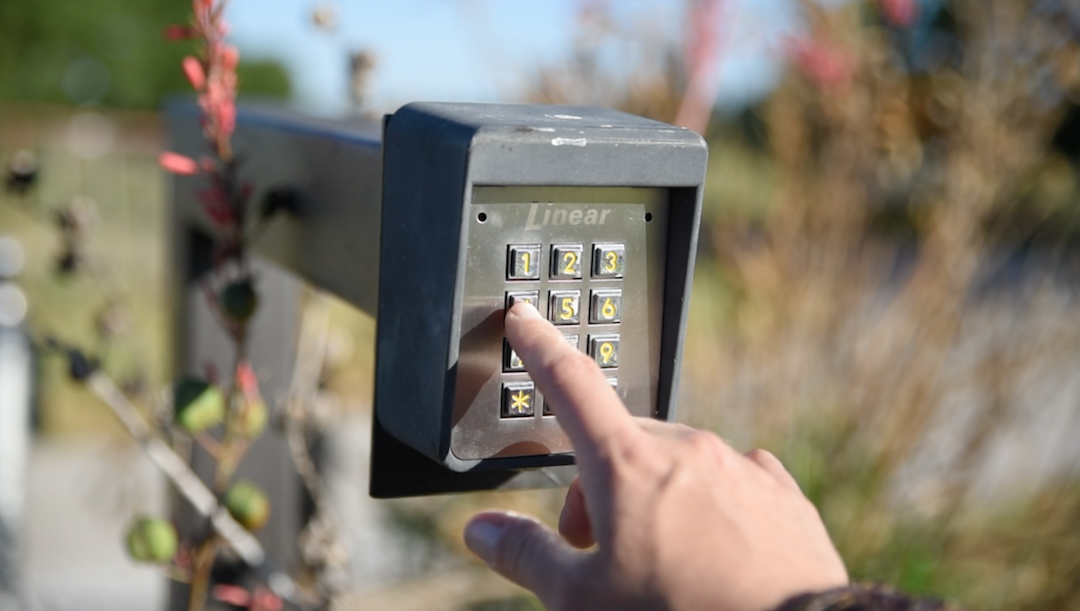Living in a gated community or access controlled apartment buildings is often associated with enhanced security and peace of mind. With the perception that gates serve as a barrier to unwanted visitors, many residents opt for gated communities as a means to protect their homes and families. However, the reality is more nuanced. While gates can serve as a deterrent to criminals, they are not foolproof in preventing unauthorized access. This article aims to uncover the truth about gate codes and their role in community security. So, let’s dive in and unravel the facts about gate codes and their effectiveness in ensuring the safety of gated communities.
In this article, you’ll learn
Gate Codes for Apartments
Gate codes for apartments are commonly used to secure access to the property, amenities, and vehicle gates. In many cases, gate codes are created by the apartment management team and distributed to residents and authorized visitors. These codes are typically numeric combinations that must be entered on a keypad at the entrance to gain access.
One of the benefits of using gate codes is that they provide an additional layer of security for residents and their belongings. They can also be used to restrict access to certain areas, such as pools and gyms, to those who have permission to use them. This can help prevent overcrowding and ensure that these amenities are available for use by those who live in the apartment complex.
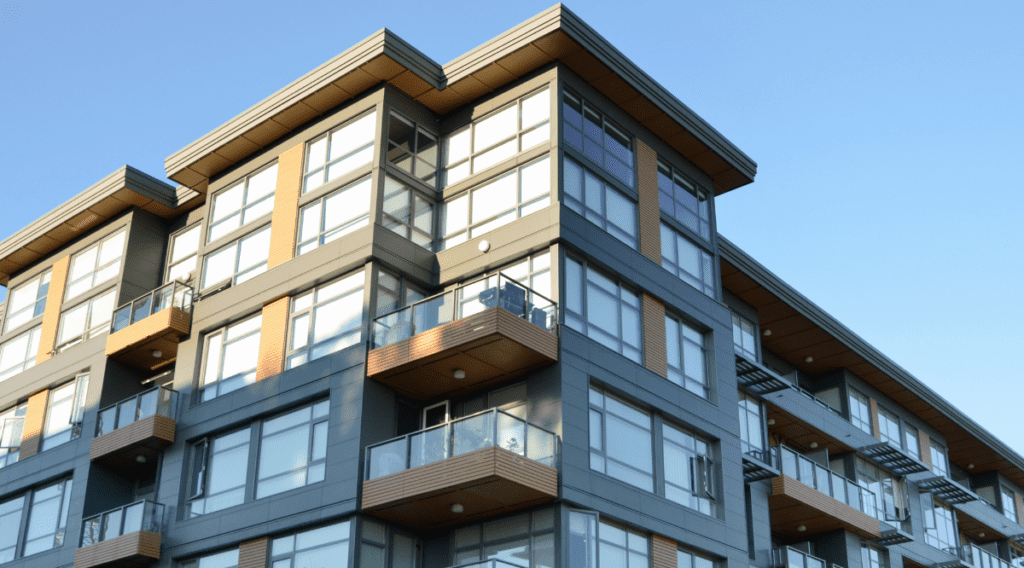
However, there are some cons to using gate codes as well. One of the biggest security risks is the potential for unauthorized individuals to gain access by obtaining or sharing the gate code. Residents who share their code with others or post it online can put the safety of the entire community at risk. Additionally, if a gate code is compromised, it can be a hassle for residents to have to constantly change it to maintain security.
Due to these vulnerabilities, many modern apartments are turning to mobile credentials on smartphones as a more secure option. Mobile credentials can be customized for each individual user and can be easily deactivated if lost or stolen. They also eliminate the need for residents to share or remember gate codes, as the access is tied to their personal device.
In conclusion, gate codes for apartments have been a popular security measure for many years, but they are not without their drawbacks. The risk of unauthorized access and the hassle of constantly changing the code have led many apartment complexes to turn to mobile credentials as a more secure and convenient option. By embracing new technology, apartment communities can provide a safer and more streamlined experience for their residents.
How do gate access codes work in gated communities?
Gated communities usually have a number of gates and doors to let people in and out. If a community has implemented gate codes for access control, the process usually looks something like this:
-
- A resident wants to enter the community in their car, so they enter a code on a keypad by the gate.
- In general, if the code is incorrect, the gate won’t open. There will be either a visual or audible signal indicating their access has been denied and that they should try again.
- When the resident has entered the correct code, a signal will be fired to open up the gate for the vehicle.
While it seems simple enough, this code-operated gate system is not as secure as you might think.

How do most gated communities set up universal gate access codes for their residents?
When a resident moves into their new home, a property manager will typically issue the resident a 4-8 digit code to gain access through the vehicle gates. Sometimes, they are offered the option to set their own gate access code. This code may be unique to the:
-
- Resident
- Resident and other household members
- Entire community
Unfortunately, whichever you choose, this code is bound to get shared with visitors and vendors.
Unique Access Code Creation
If it’s protocol that residents get their own unique codes, oftentimes, property managers will make it the last 4-8 digits of their phone number as an easy way for the resident to remember their code. Other times, it’s their birthday. When this happens, the community can end up with hundreds of code sets that allow virtually anyone who knows them to enter the gated community at will.
Some systems, in particular, don’t limit the number of times a user can attempt to enter the code at the gate. So, someone trying to get in can repeatedly try to enter various birthday dates or phone numbers until they get a match.
Regardless how the codes are generated, the overarching problem with gate codes is that they can be shared and made available to the entire city without management knowing. When this happens, now, the whole town knows how to get into your community. Worse, because everyone is using the same codes, if an incident occurs there is no way to pull up a historical report and pinpoint who used a code to gain access into the community on a specific day and time. You’re out of luck.
What are the four main problems with using gate codes for access
-
- They can be shared with anyone resulting in unauthorized individuals knowing the code.
- If more than one individual uses the same code, there is no way to identify who used the code in the case of an incident or crime.
- Changing the code results in having to update everyone’s code which can be tedious and cumbersome.
- It is less secure than more modern access methods such as RFID transponders or smartphone mobile credentials.
How do community managers stop residents from giving this code away to visitors?
When community managers implement the two solutions described above, they often find themselves in a difficult situation. If the new resident has agreed to use the temporary access code or change it to their own, they may well want to give this code to a friend, a babysitter, or other visitors who don’t plan to visit again.
Community managers need to find a way to help residents understand that it’s in everyone’s best interest not to give their code to visitors or share it with others. If visitors are coming on a one-time basis, the community manager may suggest that residents don’t give out the code but offer to meet the visitors at the gate and let them in. Or, if a telephone entry unit is available, the visitor can find the resident on the directory and just call the resident to let them inside.
What are the alternatives to gate access codes for residents
When managing access into a sprawling community or an urban building, community managers need to account for two primary groups of people: (1) residents and (2) visitors.
The problem with access codes lies in the fact that there is no differentiation between how visitors and residents get in. It’s all based on the sharing of a code, completely leaving out any unique device assigned to an individual.
Let’s first address the alternatives to gate access codes for residents.
One solution is to implement an access control solution like RFID transponders or mobile smartphone credentials. When using transponders or mobile credentials, the device is unique to the resident and cannot be shared with unauthorized visitors. For example, when a new resident moves in, you can assign a transponder to their vehicle and record their vehicle make, model, color, and license plate number.
RFID Transponders
In the case of the RFID transponders, once it gets fixed to the vehicle, whether on the headlamp or the windshield, it cannot be shared. Secure transponders are non-transferable, meaning if someone tries to take an RFID transponder off of one vehicle and put it on another, the device will deactivate.
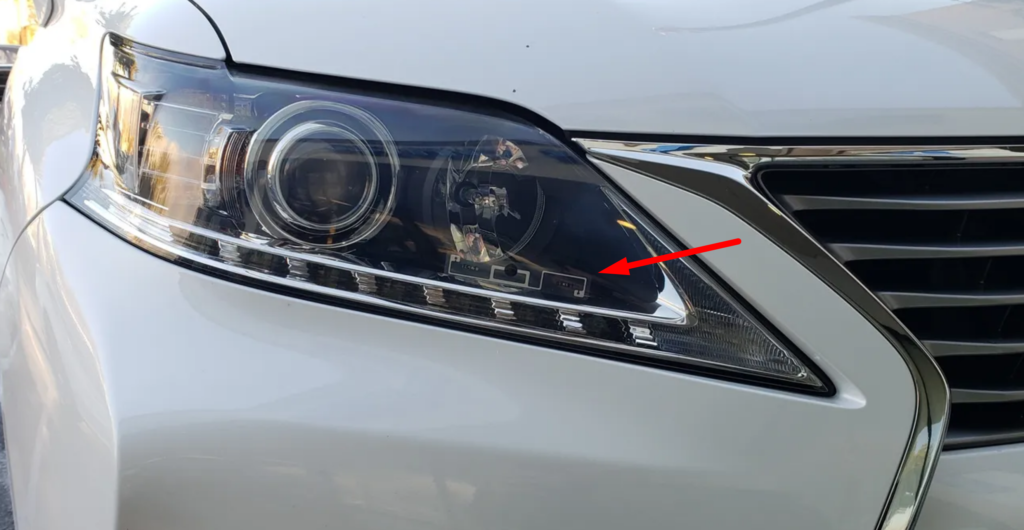
Mobile Credentials
Another option is to issue a resident a mobile credential. Similar to the RFID transponders, these credentials are unique to the device and cannot be transferred or replicated. Not only can they both be remotely activated or deactivated, you can also set activation and expiration timelines. Residents are always caring their smartphone with them whether they are in their vehicle, a rantel or Uber. Mobile credentials can be read from up to 30ft away from the reader.
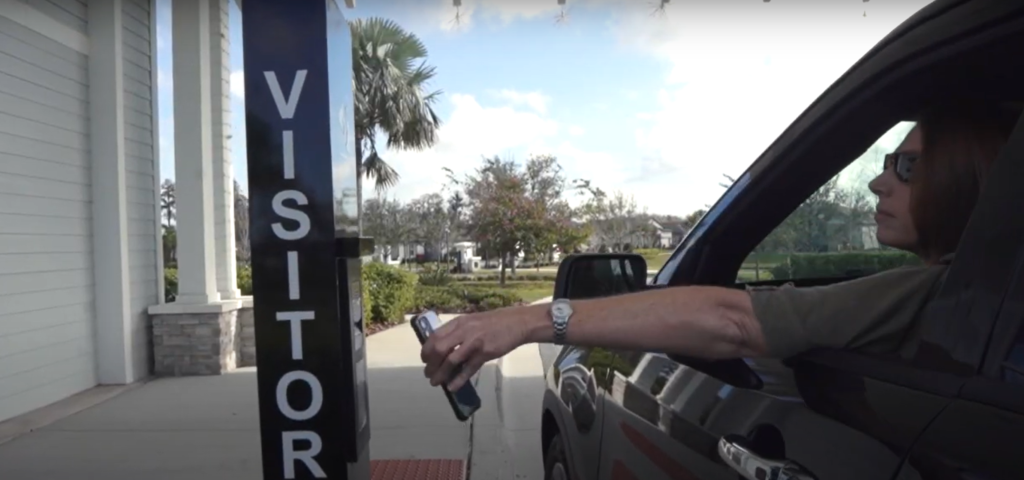
Regardless of whether you go for RFID transponders or mobile credentials, utilizing one means that you now have a much more secure access control operation. In the case of an incident, you will be able to run reports and see who accessed a specific gate or door at a specific day and time.
For example, if there was vandalism in the community clubhouse at 2 AM, you can run a report and see who used their phone to access the clubhouse between 1 AM and 3 AM. You’ll be able to see the resident’s name, their unit or property address, and the entire history of when they used their credential. Similarly, if it’s a transponder, you can identify vehicle information.
With a universal code, however, you won’t be able to know who accessed an area between 2 – 3 AM, because everyone is using the same one.
License Plate Recognition
Another popular mode of access is license plate recognition. Register a resident’s plate into the system and their method of access will be their vehicle license plate being read by a license plate reader. As long as the plate number is in the system and authorized the positve read will get the gate to open for the residents.
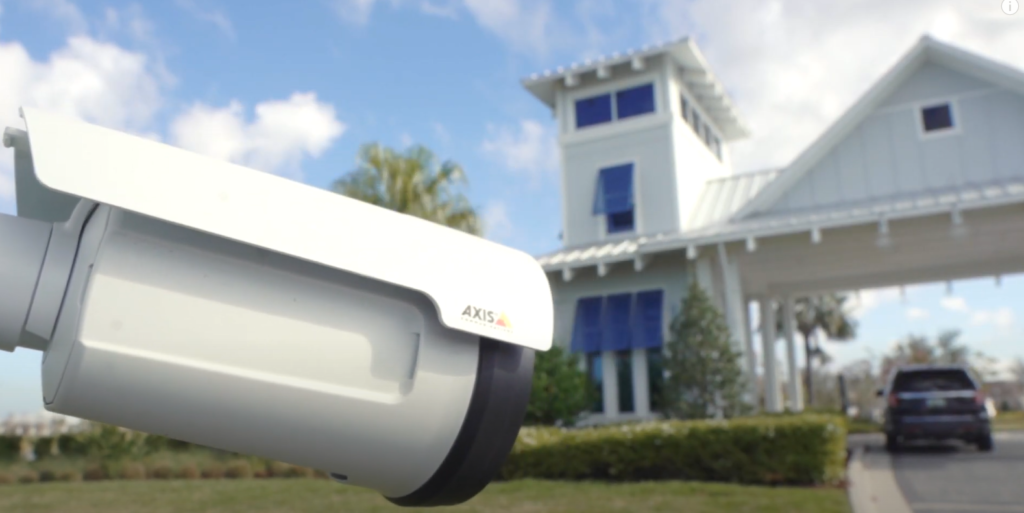
What are the alternatives to gate access codes for visitors?
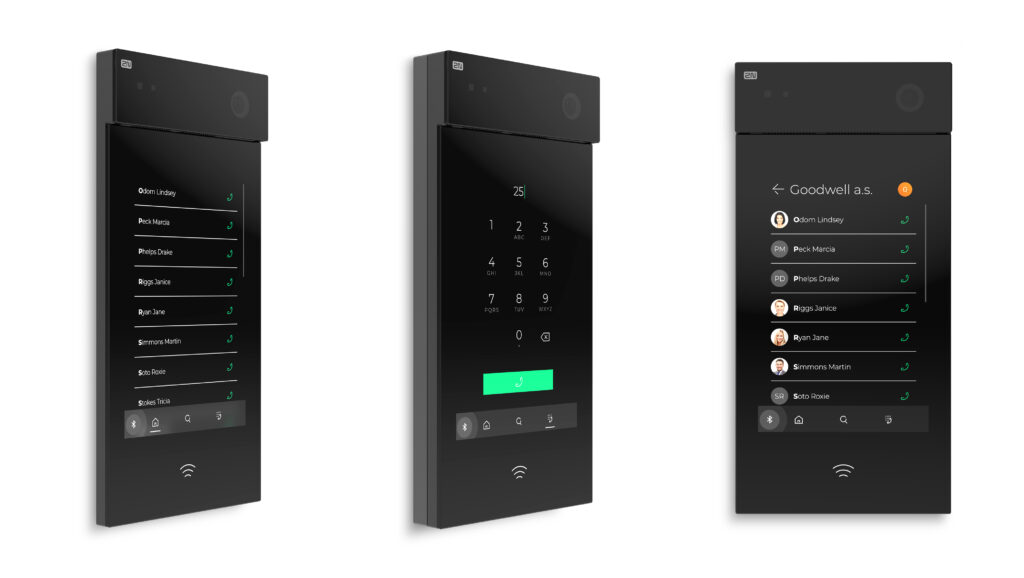
Now, let’s discuss how visitors can get in without the use of insecure gate access codes. The primary visitor management solution for gated communities that don’t have a guardhouse is telephone entry intercoms. There are several manufacturers of telephone entry intercomes, and they range in price from $1,500 to about $8,000 for the higher end modules. Proptia’s Visitor Processing Kiosks are designed to manage unmanned visitor access at vehicle gates. They come equipped with functionality that provides security and convenience for visitors. For example, instead of a visitor driving up to a pin-pad and inputting a code the resident shared with them, they can search for a resident’s name in a directory, call the resident, and the resident can press a button on a mobile app to let them in.
Even better, the resident can text their visitor a digital ePass that can be configured to have the following:
-
- A single-use or single-day unique code to allow them to access areas within the community
- A QR code that the visitor can scan at a visitor kiosk, similar to a digital boarding pass for an airline
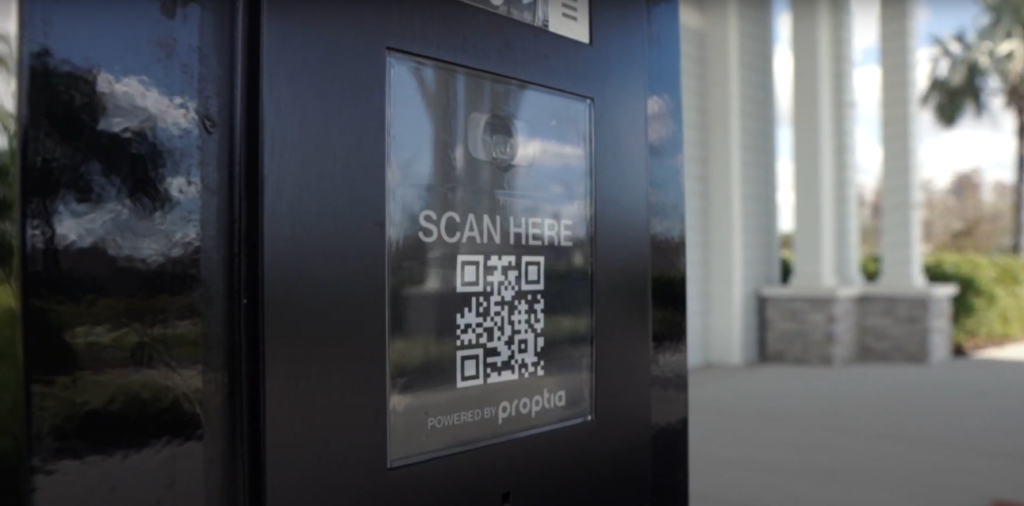
Residents can then issue these passes with specific time parameters. Relatives can have a permanent ePass, for example, while the house cleaner can only come in every Tuesday within a particular frame of time. ePasses are also unique and are set up to be valid for a predetermined length of time or number of uses. Plus, the reporting capabilities are comprehensive.
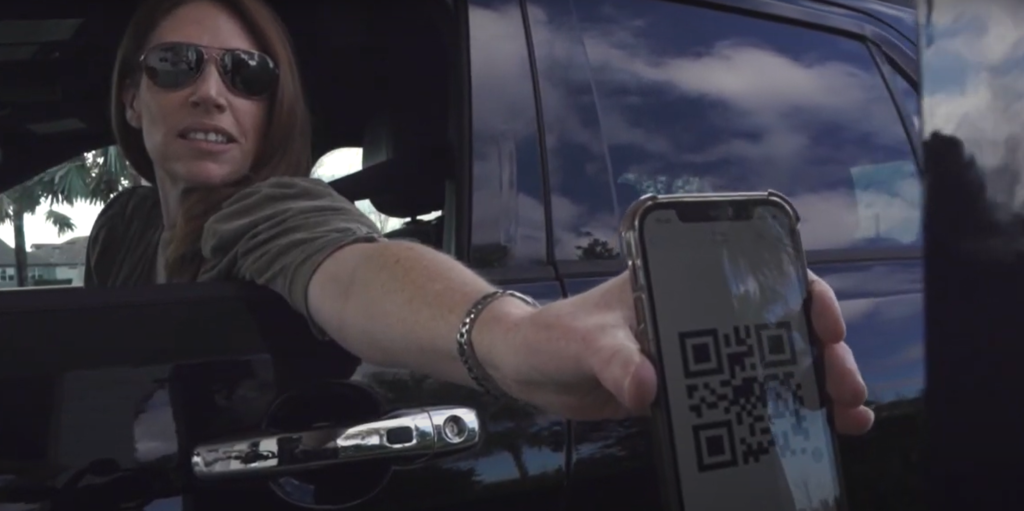
For added security, you can have the system take a photo snapshot of each visitor when they are using the kiosk as well as capture their plate. Communities that are serious about security will look to gather as much information as possible on every visitor, so in the case of an incident or crime, they can pull reports and share information with authorities. Proptia’s Telephone Entry Module provides powerful reporting for community managers and administrators:
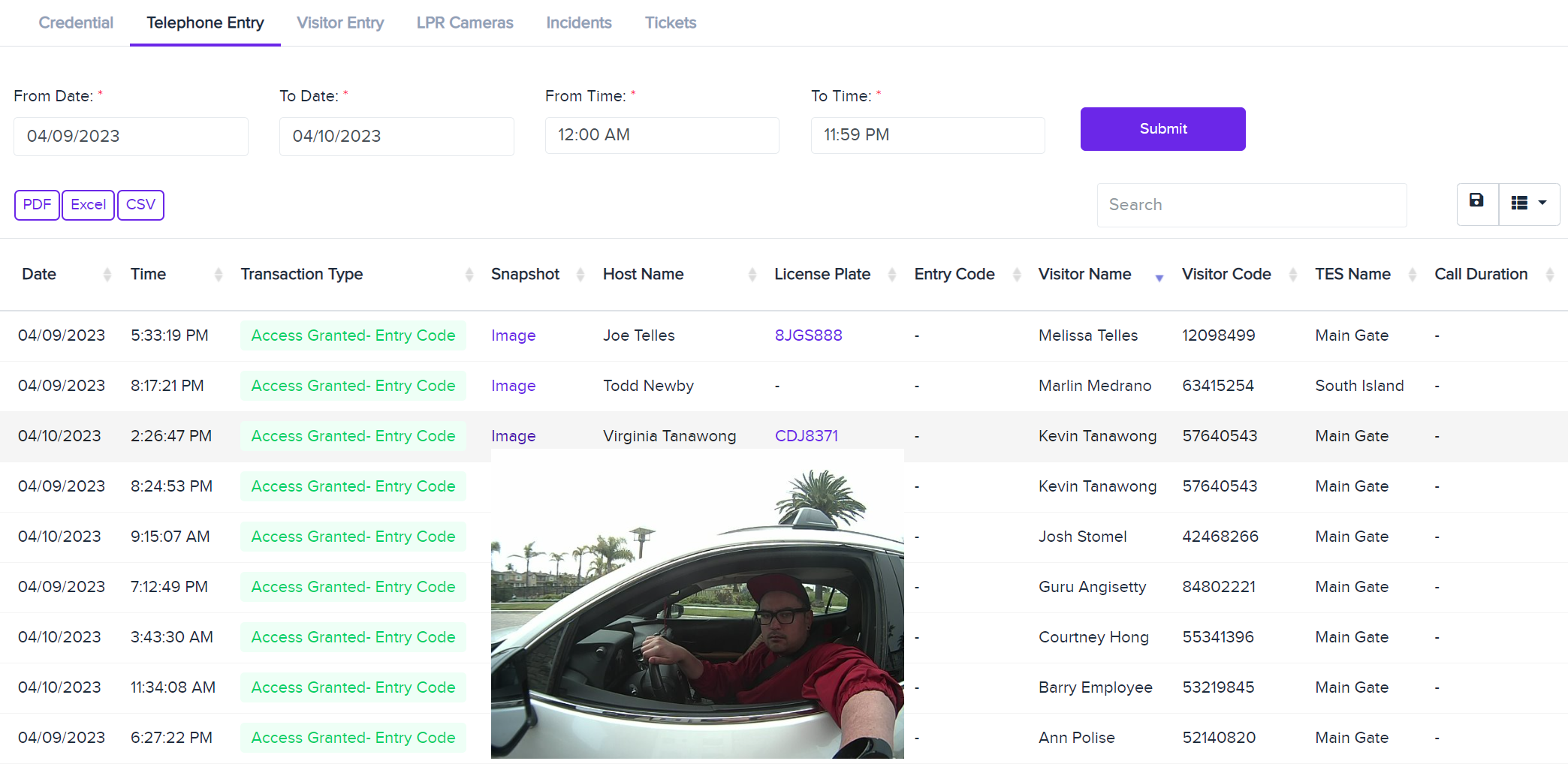
Conclusion
With so many options it can get confusing so we’ve distilled it into a thurough Guide To HOA Access Control you can read here: HOA Access Control a Comprehensive Guide
It is important to remember that gates require an added level of operational efficiency because now you have to manage access for residents, visitors, vendors, and sometimes staff.
Antiquated solutions like gate codes are not foolproof, because they are dependent on sharing the code–whether it’s the property manager sharing the code with a resident or the resident sharing their code with a visitor. Inevitably, these codes will be known by unauthorized individuals. When an incident happens, there simply won’t be enough data to accurately pinpoint who used the code. Worse, if a crime does occur, changing the code means you have the burden of updating all the homeowner codes. Unfortunately, once they get their new code and share it with a visitor, the problem starts all over again.
If you’re looking for a way to increase security, consider using Proptia visitor processing kiosks and visitor management apps. Not only do they allow you to issue mobile ePasses, but you can also manage vendors, send SMS notifications to residents, and create specific pass types for different levels of a visitor. These solutions will help the community residents keep unwanted visitors out and provide a level of security and peace of mind for everyone.
READY TO UPGRADE YOUR GATE SECURITY SYSTEM?
Schedule a Demo Now
FAQ
What are gate access codes?
Gate access codes are numeric combinations assigned to residents and authorized visitors, allowing them to enter a gated community or apartment complex by inputting the code into a keypad at the entrance
How do gate access codes work in gated communities?
Residents or visitors enter their assigned code on a keypad at the community’s entrance. If the code is correct, the gate opens to grant access. Incorrect codes result in denied entry
What are the primary security vulnerabilities of gate access codes?
-
Code Sharing: Residents may share their codes with others, leading to unauthorized access.Proptia
-
Lack of Individual Identification: Multiple individuals using the same code make it difficult to track who accessed the community at specific times.Proptia+2Proptia+2Proptia+2
-
Difficulty in Changing Codes: Regularly updating codes to maintain security can be cumbersome for property managers and residents
Why are mobile credentials considered more secure than traditional gate codes?
Mobile credentials are tied to an individual’s smartphone, making them less likely to be shared or duplicated. They can also be remotely activated or deactivated, providing greater control over access.
How can gated communities balance security and convenience for residents and visitors?
Implementing modern access control solutions like mobile authentication, RFID transponders, and visitor management systems can enhance security while providing convenient access for residents and authorized visitors.
What are the alternatives to gate access codes for residents?
RFID Transponders: Devices attached to vehicles that grant access when in proximity to the gate.
Mobile Credentials: Smartphone-based access that is unique to each resident and can be easily managed or revoked. People wont share their iPhone.
License Plate Recognition (LPR): Systems that recognize registered license plates to grant vehicle access automatically.
How can visitors gain access without using gate codes?
Telephone Entry Systems: Visitors use a directory to call residents, who can then grant access remotely
Digital ePasses: Residents send visitors a temporary digital pass, often with a QR code, valid for a specific time frame
Visitor Processing Kiosks: Self-service kiosks where visitors can request access, often integrated with resident approval systems
How can visitors gain access without using gate codes?
Telephone Entry Systems: Visitors use a directory to call residents, who can then grant access remotely
Digital ePasses: Residents send visitors a temporary digital pass, often with a QR code, valid for a specific time frame
Visitor Processing Kiosks: Self-service kiosks where visitors can request access, often integrated with resident approval systems
What challenges do delivery drivers face when accessing gated communities?
Delivery drivers often encounter difficulties such as limited or restricted access, time-consuming entry processes, and lack of standardized access protocols across different communities.

